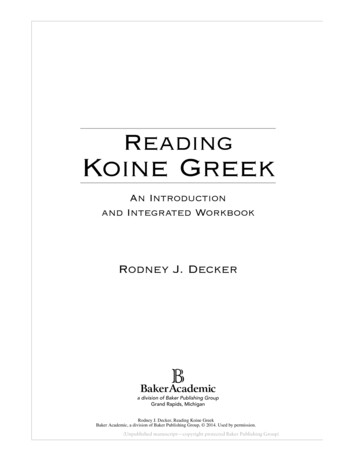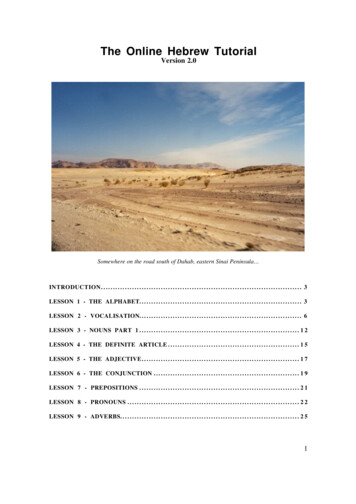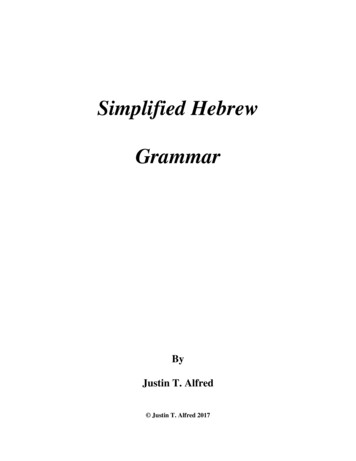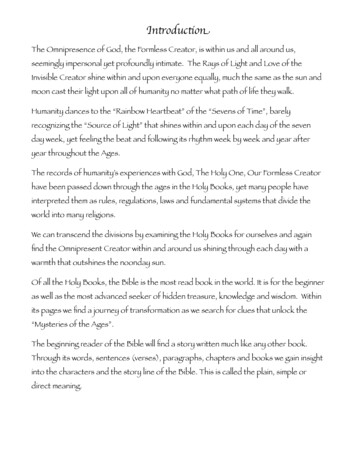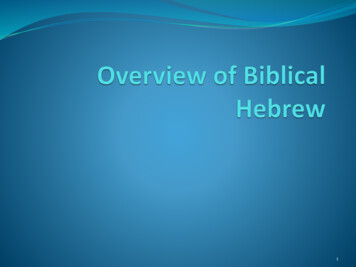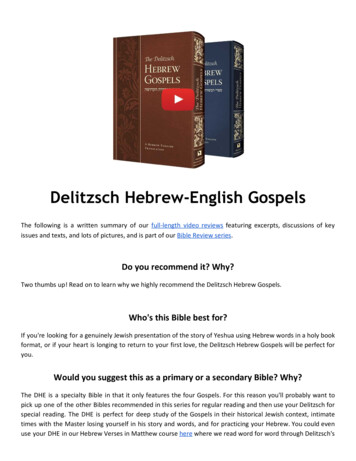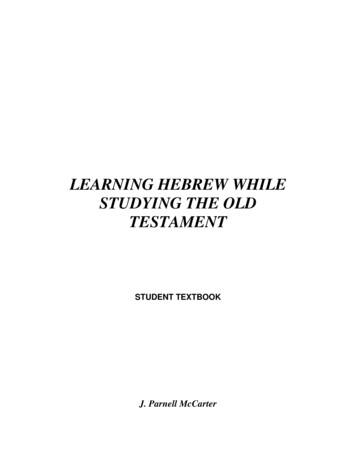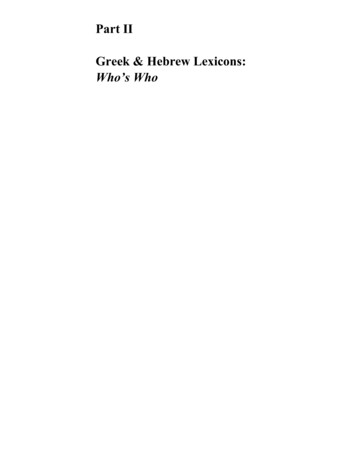
Transcription
Part IIGreek & Hebrew Lexicons:Who’s Who
158HAZARDOUS MATERIALSGreek &HebrewLexiconsby Membersof the CorruptWestcott-HortRevised VersionCommittee of 1881:STRONG,SCOTT,& THAYER
STRONG DELUSIONChapter 7Strong Delusion:James Strong’sDangerous Definitionsin the back of hisStrong’s Concordance159
160HAZARDOUS MATERIALS
STRONG DELUSIONSummary: James Strong of Strong’s Concordance1. Strong was a member of the Westcott and HortRevised Version Committee (RV) of 1881 andworked in masterminding this corrupt version.2. Strong was also a member of the American StandardVersion Committee, finally published in 1901. It saidthat Jesus Christ was a creature, not the Creator.3. On these committees Strong joined Unitarians (e.g.Thayer), a child molester (Vaughan), followers ofLuciferian H.P. Blavatsky (e.g. Ginsburg, Schaff), anda horde of Bible critics (e.g. S. R. Driver), whotogether changed nearly 10,000 words of the text.4. Strong’s Concordance definitions are often the verywords of these corrupt versions and also theKoran.5. Strong also gathered his definitions from Gesenius’corrupt Hebrew Lexicon. His work also accesses thecorrupt lexicons of Liddell-Scott, Thayer, Brown,Driver, and Briggs. All merit chapters in this book.6. Strong’s Greek text is not always that which underliesthe King James Bible.7. Strong’s various definitions may not give anywherenear a literal translation of the Greek.8. Some of the latest editions of Strong’s Concordanceare not even Strong’s original. In the Greek andHebrew lexicons in the back section, they contain evenmore corrupt definitions from new version editors. Inthe main body of the concordance, which originallywas correct, new editions omit important KJB usagesof the word ‘Jesus’ in order to match corrupt newversions.161
162HAZARDOUS MATERIALSJames Strong’s Concordance Greek and Hebrew LexiconJames Strong (1822-1894), author of Strong’sConcordance, has been elevated to the position of fourthmember of the Trinity by many. His corrupt Greek andHebrew definitions pepper today’s preaching, as if his lexiconwas the final and 67th book of the Bible. His liberal definitionsare used as quick and weak patches to fill a void in sermons.The space would be better filled by a laborious looking up of allthe Bible’s usages of a word.James Strong of the Corrupt RSV and ASV CommitteesStrong’s liberal views got him a Committee seat on thecorrupt Revised Version (RV) of 1881 with Westcott, Hort,and Vaughan, as well as a seat on the American StandardVersion (ASV) committee with Schaff and Unitarian J. HenryThayer (finally published in 1901). Westcott and Hort soughtAmerican Bible critics to join them in their work on theRevised Version. In 1870 the British Committee voted “toinvite the cooperation of some American divines” (Matthew BrownRiddle, The Story of the Revised New Testament American Standard Edition, Philadelphia:The Sunday School Times, 1908, p. 11). Strong became “a member of theOld Testament company of revisers” (New Schaff-Herzog Encyclopedia ofReligious Knowledge, New York: Funk and Wagnall’s Company, vol. XI, p. 115). Strongwas hand-selected by American RV chairman Philip Schaff,who was also a participant in the new age Parliament of WorldReligions.“The Rev. Philip Schaff, D.D., LL.D., Professorof Sacred Literature in The Union TheologicalSeminary, New York, by invitation of theEnglish New Testament Company prepared adraft of rules for cooperation, and a list of names
STRONG DELUSION163of biblical scholars who should probably bestrepresent the different denominations and literaryinstitutions in this movement. The suggestionswere submitted to the British Committee andsubstantially approved” (Introduction by Dr. Schaff to TheRevision of the English Version of the New Testament, 1872).Philip Schaff denied the inspiration of the Bible and onlychose committeemen who agreed that the Bible had never beeninspired; he called ‘inspiration,’ “the moonshine theory of theinerrant apostolic autographs” (See New Age Bible Versions for more details, p.458; David Schaff, The Life of Phillip Schaff, NY: Scribner’s Sons, 1897, pp. 439, 351, 357,Their ASV Preface jabs that, “The Hebrew text isprobably corrupt ” (p. vii).434-435).Strong “was able to sympathize with the modern movement.”An article expressing Strong’s desire to draw young men into a“Seminary” where they could learn such liberalism “provokedboth criticism and opposition.” One wise soul wrote “in reply toDoctor Strong’s proposition,” that “there should be oneprofessor at least with the title ‘P.P.R.,’ that is, ‘Professor ofPlenty of Religion’” (Charles Sitterly, The Building of Drew University, NY: TheMethodist Book Concern, 1938, pp. 82, 255, 41).Strong and the American Committee of the RV worked withWestcott and Hort on the details of the Revised Version “andthe results of the deliberations were exchanged across the sea”(Schaff-Herzog, s.v. Bible Versions, vol. II, p. 139). I have a Revised Versiondated 1881 entitled The Parallel Bible, The Holy Bible beingthe King James Version Arranged in Parallel Columns with theRevised Version, published by H. Hallett & Co., Portland,Maine. It lists both the British and the American committeemembers, placing Strong on the same page as members of theBritish revision committees (see Old Testament prefatory pages, no pagenumbers). The 1911 Encyclopedia Britannica tells the whole story.
164HAZARDOUS MATERIALS
STRONG DELUSION165The ancient occult ceremony wherein a lion’s paw resurrects an initiate from a coffin (See p. 401) isrepresented by the hand signals of men from as early as the Egyptian ruler, who built the pyramids, tomodern masons, occultists and others. 1) Egyptian ruler, Khufu 2) Origen, first Bible corrupter, 3)Richardson’s Monitor of Freemansonry 4) Luciferian, Annie Besant 5) Karl Marx, 6) Baron Rothschild, 7)Billy Graham, 8) Pat Robertson, Time, Feb. 17, 1986, 9) Satanist Anton LaVey, 10) Mr. Spock, 11)Duncan’s Masonic Ritual and Monitor. The split fingered version, seen under Philip Schaff’s vest, is called“The Real Grip of a Master Mason” and represents the wicked Cabalistic use of the Hebrew letter shin. Thehand of lexicographer Henry Liddell, seen on page 204, may evidences this split.
166HAZARDOUS MATERIALS(Revised Version New Testament Committeemen, who workedwith Westcott and Hort and also wrote lexicons or otherreference books cited herein include Trench, Scott, Vaughan,Milligan, Moulton, and Thayer. RV Old Testament revisers andlexicographers include Driver and Ginsburg.)
STRONG DELUSION“Negotiations were opened with the leading scholars ofthe Protestant denominations in America, with theresult that similar companies were formed in theUnited States. The work of the English revisers wasregularly submitted to their consideration; theircomments were carefully considered and largelyadopted, and their divergences from the versionultimately agreed upon were printed in an appendix tothe published work [1881]. Thus the Revised Versionwas the achievement of English-speaking Christendomas a whole The reviser’s first task was to reconstructthe Greek text the revisers were privately suppliedwith installments of Westcott and Hort’s text ”(Encyclopedia Britannica, 1911, vol. 3, p. 903).167
168HAZARDOUS MATERIALSStrong Contentions Brings the ASVWhen Strong began working with the Westcott-HortVaughan RV committee, there were no plans for the Americanparticipants to produce their own edition. However, hostilitieseventually ensued as a few of the suggestions by theseAmericans were not accepted by the British participants.Westcott and Hort had changed approximately 9,970 wordsfrom the traditional Greek New Testament. But the Americanswanted to make more changes by watering down and furthersecularizing the remaining vocabulary. The ensuing clash andlegal battles between the British and American participants inthe RV are revealed in New Age Bible Versions and The Life ofPhilip Schaff. Strong and the Americans finally published theircorrupt ideas in a revised Revised Version, called the AmericanStandard Version. Strong’s liberal ASV is the backbone of thenow distorted New American Standard Version.“When the English Company had completed thefirst revision of a portion of the Bible, it was sentto the American Company for consideration andadvice [T]he English companies were not ableto concur in all of the preferences expressed bythe American companies and so when theEnglish Revised Bible was published it includedby agreement a statement of all of the nonconcurred-inAmericanpreferences,inconsideration of which the American companiesbound themselves not to print or encourage theissue of any other revised bible until after theexpiration of fourteen years from the date of thepublication of the English Revised Bible” (Frank J.Firth, The Holy Gospels: A Comparison of the Gospel Text as It Is Givenin the Protestant and Roman Catholic Bible Versions in the EnglishLanguage in Use in America, New York: Fleming H. Revell, 1911, p. 9).
STRONG DELUSION169“The revised New Testament [RV] waspublished in England May 17, 1881 Americahad a peculiar reason for complaint, seeing thatmany an expression which American scholarshad preferred was to be found only in theappendix, and they were bound not to issue anew edition within fourteen years. That time wasup in 1896, and the American edition[ASV] appeared in New York in 1901” (SchaffHerzog, s.v. Bible Versions, vol. II, p. 139).Even the original preface to the NASB, which was takenfrom the ASV, said of the ASV/RV connection,“The British and American [RV] organizationswere governed by rules The AmericanStandard Version, itself a revision of the 18811885 edition, is a product of internationalcollaboration ”One lexicon editor admitted,“The AV, has maintained its hold on the EnglishProtestant world until the present time. The RV,of 1885 [Old Testament completed], prepared bya joint British and American Committee, underthe authority of the convocation of Canterbury,has thus far been unable to replace it” (Charles Briggs,The International Critical Commentary, The Book of Psalms, NY:Charles Scribner’s Sons, pp. cix, cx).“The work of the revisers has been sharply criticized fromthe standpoint of specialists in New Testament Greek,” notesthe Encyclopedia Britannica (s.v. Bible, English, 1911, vol. 3, p. 904).
170HAZARDOUS MATERIALSStrong with Westcott & Hort’s Revised Version CommitteeStrong called it the “Anglo-American Committee on BibleRevision” [RV/ASV]. He states,“The textual examination of the New Test. inparticular has received a powerful stimulus bythe labors of the Anglo-American Committee onBible Revision, who had necessarily toreconsider the Greek text. Although they havenot directly put forth any new edition, yet theresults of their criticism have been embodied inThe Greek Testament, with the Readings adoptedby the Revisers of the Authorized Version(Oxford, 1881, 12 mo), which may be regardedas the most mature and impartial fruit of thecombined scholarship of the times, andprobably nearer the autograph than any othertext extant .A fierce attack has been made bysome scholars, especially opposed to Biblerevision, on the conclusions arrived at in theforegoing productions. It has been claimed thatthey unnecessarily depart from the textusreceptus, and unduly lean upon the few greatuncial MSS., to the exclusion of all other copiesand to the neglect of the early versions” (McClintockand Strong, Cyclopaedia of Biblical, Theological, and EcclesiasticalLiterature, NY: Harper & Brothers, Publishers, 1867-1887, vol. 12,Supplement, p. 171).
STRONG DELUSION171Strong Heresy in the ASVGod will not promote a bible that teaches heresy. TheRV/ASV Committee included several Unitarians (those whodeny the Trinity and other central doctrines). One such man wasAmerican Bible critic, J. Henry Thayer, author of Thayer’sheretical Greek-English Lexicon (see upcoming chapter onThayer). Therefore it is no surprise that the ASV marginal notefor John 9:38 states that Jesus Christ is just a man, a “creature,”and not God, the “Creator.” (Also see the ASV note in Matt.2:2). The ASV note for the verse, “And he said, Lord, I believe,And he worshipped him,” says,“3The Greek word denotes an act of reverence,whether paid to a creature (as here) or to theCreator ”Even more shockingly, the ASV has a similar note in Luke 4:6,7 referring to the worship that the devil requests. (“And thedevil said unto him If thou therefore wilt worship me ”)Here the ASV note omits the parenthetical (as here).“7The Greek word denotes an act of reverence,whether paid to a creature or to the Creator ”Therefore, Strong’s ASV specifies that in their opinion Jesus isa “creature,” not the Creator. But it does not specify that the
172HAZARDOUS MATERIALSdevil is a “creature” and not the “Creator”! Again, in Matt. 4:9,the ASV leaves the choice to the reader as to whether the devilis a creature or the Creator. The ASV states emphatically thatJesus is a “creature.”James Strong reveals his weak Christian convictions andlack of discernment by his participation in the RV and ASV,both of which deny the deity of Christ in numerous places (Forexamples, see the upcoming charts, as well as New Age BibleVersions, for ASV omissions still seen in the NASB). Whywould today’s Christians lurk in the back section of Strong’sConcordance to unearth this old heretic’s liberal definitions forBible words?Strong’s Weak DefinitionsAs a member of the corrupt RV and ASV committees, hepreferred his own “private interpretation” of the scriptures, evenmaking his own version of the book of Ecclesiastes in 1877(Schaff-Herzog, p. 115, s.v. James Strong). The definitions in the Greek andHebrew Lexicons in the back of Strong’s Concordance areoften not literal renderings of Greek or Hebrew words. Forexample, the Greek word deisidaimonia, used in Acts 17:22, ismade up of two words, ‘fear’ and ‘devil’ (daimon). The KingJames Bible correctly interprets ‘fearing devils’ as being “toosuperstitious.” Propelled by views that ‘other’ religions are tobe respected, Strong’s Concordance and his ASV pretend theword is “very religious.” Both the ASV and Strong’sConcordance turn a stern warning into a high compliment. (Theword deisidaimonia is discussed in depth in the chapter aboutR.C. Trench, the originator of the mistranslation “veryreligious” and the author of an anti-KJB book with theLuciferian serpent logo on the first page.)
STRONG DELUSION173When reading the so-called definitions in Strong’sConcordance (in the Greek and Hebrew Lexicons in the back),one is really often just reading the liberal and watered-downwords from Strong’s corrupt American Standard Version (andsometimes also his 1881 Revised Version). Such corrupt wordsare now echoed in versions such as the NIV, TNIV, NASB,NKJB, ESV, HCSB, NAB, NJB and others. Note the followingexamples:King James BibleGodheadStrong’sConcordanceCorrupt Lexicon‘Definition’divinityJames Strong’s &J. Henry Thayer’sAmerican StandardVersion of 1901(See corresponding corruptionsin most places in the NIV,TNIV, ESV, NASB, HCSB,NRSV, NAB, NJB, CEV, etc.)divinityone is your Master, teachereven Christone is your ceself-controlself-controltoo superstitiousvery religiousvery omless pitabyssabysshellHades1.Hades1.devilsdemonic being ,deitydemonsLucifermorning-starday-star
174HAZARDOUS MATERIALS1.If Strong intends to use a translation that still needs to betranslated (i.e. using a transliteration of Greek words, such as‘Hades’ or ‘demon’), why did he not leave the KJB’stransliterated words such as heresies (hairesis), heretic,(hairetikos), Jesus (Jesus in Heb. 4:8 & Acts 7:45), or martyr,(martur)? Strong’s ASV omits what his fellow committeemembers called “fearful” terms and “excessive conservatism,”such as the words ‘heresies,’ ‘martyr,’ ‘hell,’ and ‘devils’(Alexander Roberts D.D., Companion to the Revised Version of the English New Testament withExplanations of the Appendix by a Member of the American Committee, NY: Cassell, Peter,Galpin & Co. 1881, p. 204; Preface, ASV, p. iv).Piles of other such non-literal or secularized definitions canbe found by those who are not just playing Greek-speak. Strongadmits in his “Directions and Explanations,” on the second pageof his Concordance, that in his Concordance “a double obeliskmarks a change by the American revisers only (AmericanStandard Version 1901)”; these obelisks, showing ASV changesin the Bible, lead the way to finding where Strong’sConcordance definitions match his ASV. With an ASV in handthe facts become all too clear. Well-meaning pastors and Biblestudents are unknowingly quoting from the depraved ASV orRV, when they think they are ‘defining’ a word using Strong’sGreek or Hebrew Lexicon. Strong’s system of asterisks andsingle obelisks will also lead to many matching Westcott andHort Revised Version word choices. (Slippery new editions ofStrong’s Concordance may have slyly removed these revealingsymbols.)“An asterisk calls attention to the fact that in thetext quoted the leading word is changed in theRevised Versions; while an obelisk shows that achange has been make by the British Revisersonly (English Revised Versions 1881-85)” (JamesStrong, Strong’s Concordance, Iowa Falls, Iowa: World Bible Publishers,no page numbers; see second page).
STRONG DELUSION175Strong’s Source LexiconsAlthough Strong published the body of his Concordance in1849, it was not until 1890 that he added the lexicons in theback matter. These were entitled, “A Concise Dictionary of theWords in the Greek New Testament” and “A ConciseDictionary of the Words in the Hebrew Bible.” His admittedaccess to the corrupt lexicons of Thayer, Liddell-Scott, Brown,Driver, and Briggs tainted his new appended dictionaries of1890, which are still seen in Strong’s Concordance today(McClintock and Strong, vol. 2, p. 456; see preface page of both Dictionaries in the original1890 edition.). The McClintock-Strong encyclopedia’s article on “GreekLanguage” points to “Thayer’s” Unitarian Greek lexicon of“1887,” including it in its list of the “best” and the “latest”lexicons (vol. 3, p. 988). Even the old Kitto’s Cyclopedia (Dr.Donaldson’s article) concedes the error of defining wordsby using the context of the pagan classics, as Strong andThayer do. Of the Holy Bible’s “Vocabulary,” Donaldsonadmits,“The new thoughts [Christian] demanded newmodes of expression, and hence the writers didnot hesitate to use words in senses rare, if notentirely unknown to the classical writers.”Donaldson adds, “ the grand moral ideas that were expressedby some of them are unique in the age in which they wereuttered” (as cited in McClintock and Strong, vol. 3, p. 987).Strong calls Thayer’s corrupt edition of Winer’s Greekgrammar the “best” (McClintock and Strong, vol. 3, p. 988). Strong’s encyclopedia also recommends the work on NewTestament Synonyms by R.C. Trench, whose blasphemous
176HAZARDOUS MATERIALSviews and proposed changes to the Bible merit an entirechapter in this book (McClintock and Strong, vol. 3, p. 988). He recommends at least eight German-based lexicons,which stem from the German schools led by higher criticsand infidels (McClintock and Strong, vol. 3, p. 988). He cites under his list of “best” lexicons, the edition of 1829from John Parkhurst, who labored in the 1700s, writingpolemics against John Wesley. It has been suggested thatthis lexicon may contain “ridiculous etymologies bearingtraces of the Hutchinsonian opinions of their author”(McClintock and Strong, vol. 7, p. 694; vol. 4, p. 426). In his encyclopedia, just as in the Strong’s ConcordanceLexicon, there is an admission of his use of Gesenius’Hebrew Lexicon, whose dangers and heresies merit anentire chapter in this book (e.g. McClintock and Strong, vol. 1, p. 3, vol. 2,p. 75, vol. 4, p. 168 et al.). He even admits that “Gesenius was anoutspoken adherent of the Rationalistic school,” and assuch, he “began a new era,” revolutionizing and secularizingHebrew study (McClintock and Strong, vol. 3, p. 839). He includesGesenius with a list of German higher critics (McClintock andStrong, vol. 2, p. 568). Strong exhibits his ready access to the pagan infestedLiddell-Scott Greek-English Lexicon. He mentions, “Thelearned authors of Liddell and Scott’s Greek Lex .”(McClintock and Strong, vol. 4, p. 166).Strong’s Weak Greek TextStrong’s ASV and RV derived definitions are not the onlysnares set to pull Bible students away from their King JamesBibles and toward his revised versions. Strong’s “Greek” text isnot in all points the “Originall” to which the King Jamestranslators had reference (see KJB 1611 original title page). For
STRONG DELUSION177example, in Acts 19:20 Strong pretends that the Greek word iskurios (Lord), the reading in his RV. In fact, the KJB’s“Originall Greeke” word was theos, ‘God,’ as seen in Greekmanuscripts from as early as the 5th and 6th centuries (i.e. D andE). These represent a much older text. The word “God”dominates the most ancient versions and vernacular editions,such as the Syriac, syrp (fifth century), the Armenian Bible,written in the 300s by Chrysostom, and the Old Itala, itd, itw(MS dated in the fourth century and representing the originalOld Latin reading). Beza’s Codex Cantabrigiensis uses “God”in both its Greek and Latin text (Bezae Codex Cantabrigiensis, ed. Frederick H.Scrivener, Cambridge: Deighton, Bell and Co., 1864).More Strong Heresies in the ASVThe following chart shows just a few of the places whereJames Strong and fellow ASV member and Unitarian friend, J.Henry Thayer, denies the deity of Jesus Christ. Most newversions echo their heresy.VerseKing James BibleJames Strong’s &J. Henry Thayer’sAmerican Standard Version(Check the NIV, TNIV, NASB, ESV,HCSB, and most new versions, whichusually omit the same words.)1 John 4:3And every spirit thatconfesseth not that JesusChrist is come in theflesh is not of Godand every spirit thatconfesseth notJesus is not of GodCol. 1:2our Father and theLord Jesus Christour Father
178HAZARDOUS MATERIALSVerseKing James BibleJames Strong’s &J. Henry Thayer’sAmerican Standard Version(Check the NIV, TNIV, NASB, ESV,HCSB, and most new versions, whichusually omit the same words.)Eph. 3:9God, who created allthings by JesusChristGod who created all thingsEph. 3:14I bow my knees unto I bow my knees unto thethe Father of our FatherLord Jesus ChristGal. 4:7an heir of God an heir of Godthrough ChristGal. 5:6For in Jesus Christneither circumcisionavaileth any thing1 Tim. 2:7I speak the truth in I speak the truthChrist1 John5:13These things have I These things have I writtenwritten unto you that unto you, that ye may knowbelieve on the name that ye have eternal life of the Son of God;that ye may know thatye have eternal life Rev. 14:14the Son of mana son of manRev. 1:13the Son of mana son of manFor neither is circumcisionanything
STRONG DELUSIONVerseKing James Bible179James Strong’s &J. Henry Thayer’sAmerican Standard Version(Check the NIV, TNIV, NASB, ESV,HCSB, and most new versions, whichusually omit the same words.)John 6:47He that believeth onme hath everlastinglifeHe that believeth hatheternal lifeMark10:21and come, take upthe cross, and followmeand come follow meActs 8:37I believe that Jesus omitChrist is the Son ofGodRomans1:16For I am not ashamedof the gospel ofChristActs 22:16calling on the name of calling on his namethe Lord1 Tim.3:16God was manifest in He who was manifested inthe fleshthe fleshPhil. 4:13I can do all things I can do all things in himthrough Christ1 Cor.16:22If any man love notthe Lord Jesus ChristFor I am not ashamed of thegospelIf any man loveth not theLord
180HAZARDOUS MATERIALSVerseKing James BibleJames Strong’s &J. Henry Thayer’sAmerican Standard Version(Check the NIV, TNIV, NASB, ESV,HCSB, and most new versions, whichusually omit the same words.)Acts 19:10Lord JesusLord2 John 1:3the Lord Jesus ChristJesus Christ2 Tim. 4:1the Lord Jesus ChristChrist Jesus2 Cor.4:10the Lord JesusJesusO.T.LORDJehovah(By usually omitting the LORD from theO.T. and omitting ‘Lord’ from the title ofJesus Christ, Strong has managed to denythat Jesus is the Lord God of the OldTestament. The ASV’s preface called it“Jewish superstition” to call him “God”or “LORD.” This ASV idea fits perfectlywith the Higher Criticism of their daywhich believed that Jehovah (not theKJB’s all capital JEHOVAH) was thename of a tribal god, not THE only GOD(Preface, p. iv.)MasterTeacher (what a demotion!)
STRONG DELUSION181Unitarianism pocks many pages of Strong’s ASV. Thedenial of the virgin birth is seen in the ASV and new versions inLuke 2:33. They change the KJB’s “Joseph and his mother” to“his father and his mother.” Joseph was not Jesus’ father. Theidea of God’s blood being shed is omitted twice by Strong’sUnitarian-influenced ASV. By saying the Lord’s “ blood”instead of God’s “blood,” the ASV skirts around admitting thatJesus is God.VerseKing James BibleStrong’s & Thayer’sASV(Check new version for identicalcorruptions.)Col. 1:14In whom we have in whom we have ourredemption through redemptionhis bloodActs 20:28the church of God,which he hathpurchased with hisown bloodthe church of the Lordwhich he purchased withhis own bloodTo further deny the deity of Christ, the ASV, as in mostnew versions in Phil. 2:6, moves the important word “not.” Inthe ASV and new versions Jesus believed he has“not equality with God.” The KJB affirms that, for Jesus, itwas “not robbery to be equal with God.” (Confused? Diagramthe sentence and see which words modify which words.)Strong’s ASV, like new versions, has no “Holy Ghost.” Seethe following ways Strong and Thayer’s ASV denies theTrinity.
182HAZARDOUS MATERIALSTrinityVerseKing James BibleStrong’s & Thayer’sASV(Check new version for identicalcorruptions.)1 John 5:7For there are three omitthat bear record in (In John 5:7 the NIV steals some ofverse eight to pretend they have aheaven, the Father, verse seven. The NASB steals somethe Word, and the of verse six to pretend they have averse seven. But both omit the realHoly Ghost: and these verse 7, as do most new versions.)three are one.Rom. 1:20Godhead(The Godhead is thethree persons of theTrinity. It is in the KJB3 times!)divinity*Acts 17:23THE UNKNOWNGODAN UNKNOWNGODActs 14:15the living Goda living GodHeb. 9:14Christ, who throughthe eternal Spiritoffered himself withoutspot to God[the Trinity]ASV margin suggestsreplacing “the Spirit,”the third person of theTrinity, with “hisspirit.”The ASV note for Acts 17:18equates note 8 “foreign divinities”with note 9 “demons”!This chart shows just a few of the places where Strong’sASV and new versions teach the innate goodness of all men andsalvation by works, instead of righteousness by God’s gracethrough faith in the Lord Jesus Christ alone. They omit grace in
STRONG DELUSION183Romans 11:6 and teach that obedience, faithfulness, and selfcontrol saves.VerseKing James BibleStrong’s & Thayer’sASV(Check new version for identicalcorruptions.)Rom. 11:6But if it be of omitworks, then is itno more graceJohn 3:36believethobeyethGal. 5:22faithfaithfulnessGal. 5:22, 23(Acts 24:25,2 Peter 1:6)the fruit of the the fruit of the Spirit isSpirit self-controlis temperance(Is it ‘self’ or ‘Spirit’control?)Strong’s ASV and new versions teach the equality of allreligions, as evidenced here.VerseKing James BibleStrong’s &Thayer’s ASV(Check new version foridentical corruptions.)Acts 17:22I perceive that in allthings ye are toosuperstitious I found an altar withthis inscription, TO THEI perceive that yeare very religious I found an altarwith theinscription, TO AN
184HAZARDOUS MATERIALSUNKNOWN GODUNKNOWN GODRev. 21:24And the nations of them And the nationswhich are saved shall shall walk amidstwalk in the light of itthe light thereofGal. 5:20seditions, heresies(negative)divisions, parties(neutral)Titus 3:10heretick(wrong beliefs)factious (Since the ASVeditors did not believeanything could be ‘wrong’doctrinally, then there can beno ‘heresy.’ In their‘ecumenical’ mindset theonly ‘error’ would be to bedivisive or factious.)Strong replaced ‘hell’ with Sheol in the Old Testament. One“member of the American Committee” said he believes in a“spirit-world” called Hades and agrees they should omit “thefearful word hell” (Roberts, Companion, p. 204).VerseKing James BibleStrong &Thayer’s ASV(Check new version foridentical corruptions.)Deut. 32:22hellSheol (Their ASVeven used Sheol 35times more than theRV.)hellHades(and all of OldTestament)Mt. 11:23, 16:18,Luke 10:15, 16:23,Acts 2:27, 2:31,Rev. 1:18, 6:8,
STRONG DELUSION18520:13, 14Rev. 9:1 etc.bottomless pit(too “fearful”?)N.T. & O.T.abyss(non-descriptive)judgmentjustice or ordinance(a negative penalty) (no negativeconnotation)Did Darwin’s notion of evolution or the Hindu idea ofcyclical ages prompt these men to deny the creation by God anda ‘beginning’ of the world?VerseKing James BibleStrong’s &Thayer’s ASV(Check new version foridentical corruptions.)Luke 1:70,Acts 3:21, 15:18from the beginning of oldof the worldTitus 1:2the world begantimes eternal (note:long ages ago)Strong’s bible, along with most new versions, has no‘Lucifer’ (Isaiah 14:12). Lucifer becomes the “day-star,” ofRoman mythology, which equates Lucifer with Christ. Ideasfrom Roman and Greek mythology permeate lexicons (seechapter on Thayer). Their note for Isaiah 14:12 (where ‘Lucifer’should be) gives the reader a cross reference to Jesus Christ in 2Peter 1:19, Rev. 2:28, and 22:16! This makes Jesus Christ thedevil “fallen from heaven,” “cast down to the ground,” “downto hell” and “abominable.”
186HAZARDOUS MATERIALSThe use of the writings of pagan and secular authors (as inIsa. 14:12) to study ‘word meanings’ for the Bible is discreditedeven by the Encyclopedia Britannica. It quotes one scholar assaying,“[T]he Greek of the New Testament may never beun
Strong’s Greek text is not always that which underlies the King James Bible. 7. Strong’s various definitions may not give anywhere near a literal translation of the Greek. 8. Some of the latest editions of Strong’s Concordance are not even Strong’s original. In the Greek a



